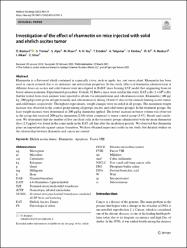Investigation of the effect of rhamnetin on mice injected with solid and ehrlich ascites tumor

View/
Access
info:eu-repo/semantics/embargoedAccessDate
2023Author
Bozkurt, Ö.Yılmaz, S.
Alpa, Ş.
Nisari, M.
Yay, A. H.
Ertekin, T.
Tokpınar, A.
Kökbaş, U.
Al, Ö.
Bozkurt, A.
Alkan, I.
Unur, E.
Metadata
Show full item recordCitation
Bozkurt, Ö., Yılmaz, S., Alpa, Ş., Nisari, M., Yay, A. H., Ertekin, T., ... & Unur, E. (2023). Investigation of the effect of rhamnetin on mice injected with solid and ehrlich ascites tumor. Medical Oncology, 40(4), 124.Abstract
Rhamnetin is a flavonoid which contained in especially clove, such as apple, tea, and onion plant. Rhamnetin has been used in cancer research due to its antitumor and antioxidant properties. In this study, effects of rhamnetin administration at different doses on ascites and solid tumors were investigated in Balb/C mice bearing EAT model that originating from rat breast adenocarcinoma. Experimental procedure: Overall, 92 Balb-c mice were used in this study. EAT cells (1 × 106 cells) that harvested from stock animals were injected to all rats via intraperitoneal and subcutaneous route. Rhamnetin (100 µg/kg-200 µg/kg) were given intraperitoneally and subcutaneously during 10 and 15 days to the animals bearing ascites tumor and solid tumor, respectively. Throughout experiments, weight changes were recorded in all groups. The maximum weight increase was observed in the control group among all groups (ascites and solid tumor groups). In the treatment groups, the least weight increase were determined in 200-µg/kg rhamnetin applied. The lowest increase in tumor volume was observed in the group that received 200-µg/kg rhamnetin (2.84) when compared to tumor control group (3.67). Result and conclusion: We determined that the number of live and dead cells in the treatment groups administered with the mean rhamnetin dose (2.5 µg/ml) was found in the count made in the EAT cell line after the incubation periods. We observed that rhamnetin plays an important role against cancer formation. We have obtained important results in our study, but detailed studies on the relationship between rhamnetin and cancer are needed.















